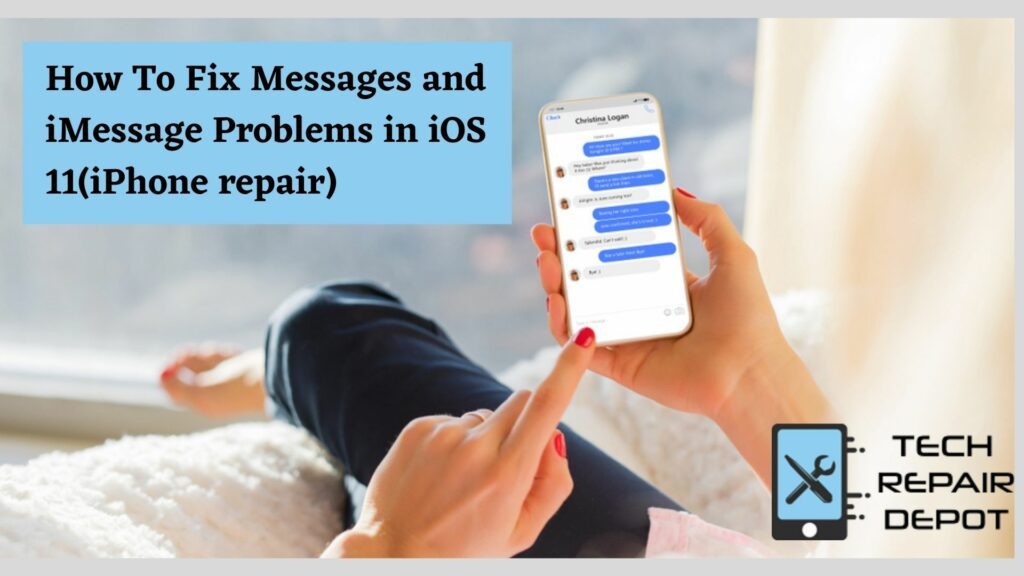
There are many iPhone repairs that can be done by a technician, but there are also some common iPhone problems that you may want to fix yourself or need to have experts like screen repair, battery replacement, cracked screen. This blog post will tell you how to troubleshoot and fix iMessage and message issues in iOS 11.
What’s New in Messages for iOS 11?
We loved the massive iMessage redesign that iOS 11 offered us! Things are a little more manageable with iOS 11. Even said, there are some cool new features to check out, like a redesigned App Drawer and a few new screen effects (Echo and Spotlight). iPhone repair in Montgomery is a certified repair service provider that might help you.
iOS 11’s Message App Drawer
The revamped app drawer in iOS 11 makes things flow better and has a more integrated look and feel. For example, when you press the “A” icon now, you’ll be prompted to download the iMessage app from the App Store. Previously, that section would display your most recently used iMessage apps. The new App Drawer is fantastic! In iOS 11, it’s a lot easier to access apps, emoji, games, stickers, and even Apple Pay from the bottom of your Message screen. It’s as simple as swiping and tapping. If you may need help to utilize it, electronic repair in Montgomery will be a reliable service provider.
Don’t Want To See Message’s App Drawer?
If you have a small-screen iPhone, such as the SE or 5S, you might choose to use that screen real estate to type messages rather than show the app menu. Or perhaps you do not wish to view this feature. Whatever the case may be, there is a way to make the app drawer vanish. It’s also simple. Press and hold the gray App Store icon next to the text entry field once you’ve started or continued a chat discussion. Hold for a few seconds and then release your app drawer will vanish. But only for a short time. The app drawer will appear the next time you open that discussion or send another message and you may need a professional service like the Montgomery cellphone repair.
Peer-to-Peer Payments
You send and receive money with Apple Pay and a connected debit or credit card using the Apple Pay Messages app. Receiving is, of course, always preferable to sending! Using your Touch ID, send money in Messages. In Apple’s new Pay Cash Card in your Wallet app, you can receive any peer-to-peer cash. Use the same Pay Cash Card for all Apple Pay purchases, or transfer the funds to your associated bank account. Of course, sending money over Messages necessitates the use of an Apple Pay-enabled handset. However, that list has grown to include the iPhone SE, iPhone 6 models or after, all iPad Pro models, the iPad 5th generation, iPad Air 2, iPad mini three or later, and your Apple Watches. If you need a fast service check through our website for phone repair in Montgomery.
But the biggest iOS 11 Update for Messages is Storage Management
It’s not sexy, and it’s probably not very enjoyable. However, controlling the storage on your iPhone, iPad, or iPod is critical. Especially for those of us with 16GB phones who have experienced the agony of receiving the dreaded “Storage Almost Full” or “Cannot Take Photo” warnings. The days of torment are over, and bliss has arrived! You may manually delete all undesirable message attachments, including Conversations, Photos, Videos, GIFs, Stickers, and Others, using OS 11. (like pdfs, audio files, and so forth.)
Looking To Get Rid of The Delete Message Confirmation?
Apple included a new clearance process for deleting texts and message chats with the introduction of iOS 11.3. You must now confirm your deletion requests rather than simply swiping to delete. So now there are three steps to deleting each communication (swipe, tap delete, then ensure.)
Unfortunately, there is no way to return to the old method of deleting messages and texts at this time. So, if you’re one of the people who despise this move, consider sending Apple a statement through its product feedback site.
Not Receiving iMessages? Is iMessage Down?
So it’s not always YOU; it’s always me (me=Apple, not AppleToolBox)! Apple System Services fall from time to time. That encompasses everything from the App Store to Apple Music to iCloud to iBooks, as well as iMessage. So, before you go to any lengths, check Apple’s System Status page to determine if the issue is occurring on their end of the fence.
iMessage Not Working on iPad or iPhone? Review the Basics!
In our years of dealing with iOS updates and the resulting texting and Message App troubles, we’ve found that the following ten solutions solve the vast majority of issues! So, let’s get this party started. First, double-tap the Home button to restart the Messages app, then swipe to the app to force quit it. You will not lose any data or communications, so don’t worry. Restart the Messages app after that. Make sure you’re pressing the Message send button with enough finger or pen pressure (the upward pointing arrow icon to the right of your message.) And that you’re holding the touch for a more extended period than usual to bring up the send with effects menu.
Make sure your phone number AND Apple ID (or iCloud email) are both present and have a checkbox next to them. Toggle ON Messages. Filter Unknown Senders and Show Contact Photos By pushing and holding the off/on button until the slider appears, you can restart your iOS device. Turn off and on Airplane Mode iMessage can be turned on and off. Make sure SMS and MMS are turned on. Check to see whether your font size was reset after the upgrade. It’s possible that resetting the network settings will solve the problem. But if you still can’t get the iMessage working, it’s better to go to a local iPhone repair or iPhone repairs shop.
Try a Forced Restart
Press Home and Power at the exact moment on an iPhone 6S or lower, as well as all iPads and iPod Touches, until you see the Apple logo.
For the iPhone 7 or iPhone 7 Plus, follow these steps: For at least 10 seconds, press and hold the Side and Volume Down buttons until the Apple logo appears.
If you’re using an iPhone X, iPhone Xs, iPhone 8, or iPhone 8 Plus, follow these steps:
- Quickly press and release the Volume Up button.
- Quickly press and release the Volume Down button.
- Hold down the Side button until the Apple logo appears.

